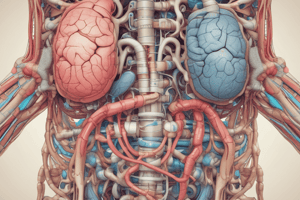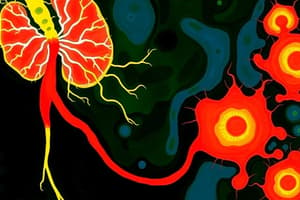Podcast
Questions and Answers
Which of the following is NOT a typical stimulus for the sensory nerves in the gastrointestinal tract?
Which of the following is NOT a typical stimulus for the sensory nerves in the gastrointestinal tract?
- Normal muscular contractions of the gut wall (correct)
- Irritation of the gut mucosa
- Excessive distension of the gut
- Presence of specific chemical substances in the gut
The sacral parasympathetic nerves primarily affect which region of the gastrointestinal tract?
The sacral parasympathetic nerves primarily affect which region of the gastrointestinal tract?
- Distal half of the large intestine and anus (correct)
- Small intestine
- Esophagus and stomach
- First half of the large intestine
Which effect does sympathetic innervation primarily have on the gastrointestinal tract?
Which effect does sympathetic innervation primarily have on the gastrointestinal tract?
- Inhibition of intestinal tract smooth muscle (correct)
- Stimulation of digestive secretions
- Increased peristalsis
- Enhanced local reflexes within the gut wall
What is the primary mechanism by which norepinephrine (NE) from sympathetic nerves inhibits the gastrointestinal tract?
What is the primary mechanism by which norepinephrine (NE) from sympathetic nerves inhibits the gastrointestinal tract?
Which spinal cord segments are the origin of sympathetic innervation of the gastrointestinal tract?
Which spinal cord segments are the origin of sympathetic innervation of the gastrointestinal tract?
What is the effect of the gastrocolic reflex?
What is the effect of the gastrocolic reflex?
Which of the following reflexes involves signals from the colon and small intestine to inhibit stomach activity?
Which of the following reflexes involves signals from the colon and small intestine to inhibit stomach activity?
What is the function of the colonoileal reflex?
What is the function of the colonoileal reflex?
Which of the following is the primary function of the myenteric plexus?
Which of the following is the primary function of the myenteric plexus?
The submucosal plexus is mainly concerned with controlling function within the inner wall; which of the options is NOT a function of the submucosal plexus?
The submucosal plexus is mainly concerned with controlling function within the inner wall; which of the options is NOT a function of the submucosal plexus?
What is the effect of stimulating the myenteric plexus on the rhythmical contractions of the gut?
What is the effect of stimulating the myenteric plexus on the rhythmical contractions of the gut?
If the connection between the extrinsic nerves and the enteric nervous system is cut, what happens?
If the connection between the extrinsic nerves and the enteric nervous system is cut, what happens?
Which neurotransmitter, found in the enteric nervous system, is known to increase intestinal secretion?
Which neurotransmitter, found in the enteric nervous system, is known to increase intestinal secretion?
Sensory nerve endings in the gut wall send afferent fibers to multiple locations. Which of the options is the LEAST likely destination?
Sensory nerve endings in the gut wall send afferent fibers to multiple locations. Which of the options is the LEAST likely destination?
What effect would norepinephrine (NE) released by sympathetic nerves have on gastrointestinal function?
What effect would norepinephrine (NE) released by sympathetic nerves have on gastrointestinal function?
Which of the following neurotransmitters found in the enteric nervous system is associated with decreasing gastrointestinal motility and secretion?
Which of the following neurotransmitters found in the enteric nervous system is associated with decreasing gastrointestinal motility and secretion?
Flashcards
Sensory Nerves in Gut
Sensory Nerves in Gut
Local responses within the gut are triggered by these nerve fibers.
Parasympathetic Nerves - Gut
Parasympathetic Nerves - Gut
Part of the autonomic nervous system that increases digestive activities.
Intrinsic Innervation
Intrinsic Innervation
Local nerve network within the GI tract wall.
Cranial Parasympathetic Nerves
Cranial Parasympathetic Nerves
Signup and view all the flashcards
Sacral Parasympathetic Nerves
Sacral Parasympathetic Nerves
Signup and view all the flashcards
Two Intrinsic Plexuses
Two Intrinsic Plexuses
Signup and view all the flashcards
Sympathetic Nerves - Gut
Sympathetic Nerves - Gut
Signup and view all the flashcards
Myenteric Plexus Location/Function
Myenteric Plexus Location/Function
Signup and view all the flashcards
Submucosal Plexus Location/Function
Submucosal Plexus Location/Function
Signup and view all the flashcards
Sympathetic Innervation Origin
Sympathetic Innervation Origin
Signup and view all the flashcards
Short Reflexes
Short Reflexes
Signup and view all the flashcards
Myenteric Plexus Stimulation Effects
Myenteric Plexus Stimulation Effects
Signup and view all the flashcards
Long Reflexes
Long Reflexes
Signup and view all the flashcards
Submucosal Plexus Function
Submucosal Plexus Function
Signup and view all the flashcards
Extrinsic Innervation Location
Extrinsic Innervation Location
Signup and view all the flashcards
Extrinsic Nervous System Components
Extrinsic Nervous System Components
Signup and view all the flashcards
Study Notes
- Neural regulation of the gastrointestinal tract (GIT) consists of intrinsic and extrinsic innervation
Intrinsic Innervation
- Refers to the local nervous system within the gut wall
- Includes the myenteric/Auerbach plexus and the submucosal/Meissner's plexus
- Lies in the wall of the gut, beginning in the esophagus, and extending all the way to the anus
- Controls gastrointestinal movements and secretion
Myenteric/Auerbach Plexus
- Located between the longitudinal and circular muscle layers
- Primarily controls gastrointestinal movements
Submucosal/Meissner's Plexus
- An inner plexus located in the submucosa
- Primarily controls gastrointestinal secretion and local blood flow
Myenteric Plexus Stimulation Effects
- Increased tonic contraction of the gut wall
- Increased intensity of rhythmical contractions
- Increased rate of rhythmical contractions
- Increased velocity of conduction of excitatory waves along the gut wall leading to more rapid peristaltic waves
Submucosal Plexus Function
- Controls function within the inner wall
- Facilitates local intestinal secretion, local absorption, and local contraction of the submucosal muscle
- Operates through various neurotransmitters like Acetylcholine (Ach), Substance P, Norepinephrine (NE), Vasoactive Intestinal Peptide (VIP), ATP, Somatostatin, 5-HT, Bombesin, Dopamine, Metenkephalin, Cholecystokinin, and Leuenkephalin
Extrinsic Innervation
- Refers to higher-level control from the parasympathetic and sympathetic nervous systems
- Connects to both the myenteric and submucosal plexuses
- Enteric nervous system can function independently of extrinsic nerves
- Stimulation by the parasympathetic and sympathetic systems can greatly enhance or inhibit gastrointestinal functions
Higher Center Innervation Sensory Feedback
- Sensory nerve endings in the gastrointestinal epithelium or gut wall send afferent fibers to the enteric system plexuses
- Information is also relayed to the prevertebral ganglia, spinal cord, and brain stem via the vagus nerves
Autonomic Control: Parasympathetic
- Cranial parasympathetic fibers supply the mouth, pharyngeal regions, alimentary tract, esophagus, stomach, and pancreas, with lesser supply to the first half of the large intestine
- Sacral parasympathetics originate in the S2-S4 segments of the spinal cord
- Travel through the pelvic nerves to supply the distal half of the large intestine and all the way to the anus
- Sigmoidal, rectal, and anal regions have significant parasympathetic innervation for defecation reflexes
Sympathetic Innervation
- Originates from the spinal cord segments T5-L2
- Preganglionic fibers synapse in the celiac and various mesenteric ganglia, with postganglionic fibers innervating essentially all of the gastrointestinal tract
- Primarily inhibitory to gastrointestinal activity
- Caused by the direct effect of secreted Norepinephrine (NE) on intestinal tract smooth muscle
- Inhibitory effect of NE on the neurons of the entire enteric nervous system.
Afferent Sensory Nerve Fiber Stimuli
- Irritation of the gut mucosa
- Excessive gut distention
- Presence of specific chemical substances in the gut
Gastrointestinal Reflexes
- Reflexes integrated entirely within the gut wall control secretion, peristalsis, mixing contractions, and local inhibitory effects
- Reflexes from the gut to the prevertebral sympathetic ganglia and back regulate various functions
- Signals from the stomach cause colon evacuation (gastrocolic reflex)
- Signals from the colon and small intestine inhibit stomach activity (enterogastric reflexes)
- Reflexes from the colon inhibit emptying of ileal contents into the colon (colonoileal reflex)
- Reflexes from the gut to the spinal cord or brain stem and back:
- Reflexes from the stomach and duodenum to the brain stem to control gastric motor and secretory activity (via vagus nerve)
- Pain reflexes cause general inhibition of the entire gastrointestinal tract
- Defecation reflexes travel from the colon and rectum to the spinal cord, producing contractions needed for defecation
Migrating Motor Complex (MMC)
- Electrical and motor activity in gut smooth muscles during the interdigestive stage, cycles lasting 90-100 minutes
- Rate of movement is 5cm/min from oral to aboral site
- Phase 1: Quiescent period with no activity
- Phase 2: Period of irregular activity
- Phase 3: Period of regular activity
- Initiated by motilin
- Gastric secretion increases, along with bile flow and pancreatic secretion .
- Food abolishes MMC by inhibiting motilin
Studying That Suits You
Use AI to generate personalized quizzes and flashcards to suit your learning preferences.
Related Documents
Description
Explore the neural control of the gastrointestinal tract (GIT), focusing on intrinsic innervation. Learn about the myenteric (Auerbach's) and submucosal (Meissner's) plexuses and their roles in controlling gastrointestinal movements, secretion, and local blood flow. Understand how stimulating the myenteric plexus affects gut wall contraction, rhythm, and peristaltic wave velocity.




